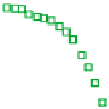Biomedical Engineering Reference
In-Depth Information
10
2
(a)
10
2
(b)
10
1
10
1
10
0
10
0
10
−
1
10
−
1
10
20
30
40
10
20
30
40
10
2
(c)
10
2
(d)
10
1
10
1
10
0
10
0
10
−
1
10
−
1
10
20
30
40
10
20
30
40
Temperature (
°
C)
Figure 10.17
Temperature dependence of G
0
(
□
,
■
) and G
00
(
○
,
●
) for 1 wt% mixed solutions of xyloglucan and
Na-gellan on cooling (open symbols) and on subsequent heating (closed symbols). Frequency
0.2 Hz; stress 0.05 Pa. TSX content: (a) 0.9, (b) 0.6, (c) 0.5, (d) 0.4. Cooling and heating rates
0.5°C min
−
1
. Reprinted with permission from Nitta et al.(
2003
) © 2003 American Chemical
Society.
solutions showed a solution-like behaviour. It is known that GG aqueous solutions
undergo a helix
coil conformational transition, so at lower temperatures, when gellan
gum is in the helix state, the values of the moduli increased even though the GG aqueous
solution was still in the sol state.
Figure 10.17
shows a steep increase in storage and loss moduli on cooling. Further, G
0
exceeded G
00
, and G
0
became much larger than G
00
at low temperatures. This data
suggests that gel formation occurs by the mixing of TSX and GG. On subsequent heating,
G
0
and G
00
decreased gradually, and then more steeply around 30°C. That is, the
characteristic temperatures at which the moduli increased or decreased were different,
and thermal hysteresis was found even at slow scan rates. Both G
0
and G
00
for the mixture
of TSX and Na-GG showed a plateau at low temperatures and smaller values of tan
-
.
These results suggest that gel formation was induced by some form of interaction, as also
revealed by DSC and circular dichroism. The appearance of a
δ
rst DSC peak at a
different temperature from the coil
helix transition of gellan gum, and the fact that this
peak was observed even at very low gellan concentrations, suggest that the
-
first peak is
probably caused by intermolecular binding. However, images obtained by atomic force
microscopy (AFM) showed no indication of heterotype junction zones (Ikeda et al.,
2004
), which may suggest phase separation. Here, however, images were obtained from





















































































































































































































































Search WWH ::

Custom Search